Let’s skip the meat of the foreplay: read this. It makes the rest of what you’re about to read juicer. Speaking of which, what you are about to read is my treatise on how a skinny-fat guy should go about changing his body from the ground up if he’s looking to lose fat and gain [...]
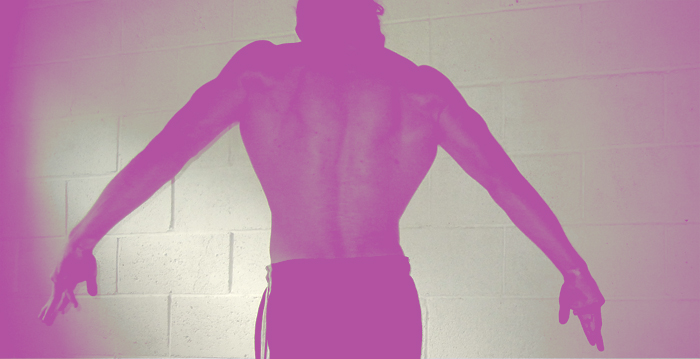
Let’s skip the meat of the foreplay: read this. It makes the rest of what you’re about to read juicer. Speaking of which, what you are about to read is my treatise on how a skinny-fat guy should go about changing his body from the ground up if he’s looking to lose fat and gain muscle.
Should you bulk? Cut? Strength train? Cardio craze?
All of those answers are here, in some cryptic sense. If you’re looking for something quick and easy, you might as well leave. We’ve come too far, and I’m not going to baby you.
Now, I know a lot of you are past day one. You might have some experience. You might be wondering where you fit in. Just know this little system is sequential. Each layer builds upon what came before it.
What this is saying is that if you’re asking a question about where to start, start at the beginning; always regress. Train with Gohan before Kame before Kai. Even if you think you might be more Kame than Gohan, it’s always a good idea to revisit the initial stage.
The first stage of skinny-fat syndrome and the skinny-fat solution
Stepping into stimulation
First and foremost, you have to stimulate for muscle. You already have a river flowing to fat. That’s just the reality of being skinny-fat. It’s your job to start opening up a tributary to muscle as soon as possible.
Strength training is the only reliable way to handle physique training long term.
This is best served by learning how to do the good exercises that are actually going to help a naturally skinnier guy build muscle. Preferably, you’d also make use of the exercises that build the “X” physique. (Or lead into more advanced exercises down the line.) Because proportion.
Translation, as far as I’m concerned: get into barbell and bodyweight exercises.
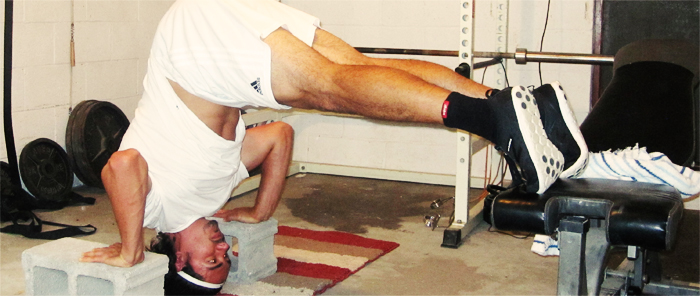
Stimulating for muscle helps control body fat because it’s a tributary. Where a sedentary body might not question flowing excess nutrients and energy to body fat, a body that’s been built on the rigors of strength training has more decisions.
Excess energy and nutrients? Well, that might be of good use for repair and upkeep of muscle when you’re regularly tearing it all down. I know I’m using to just chunking it all in these fat cells, but now . . .
This muscle vs. fat battle is what’s known as nutrient partitioning, and it’s the reason why the only reliable long term physique strategy is strength training. You can do a bunch of other physical activity to reduce the flow to the river, but few things carve the tributary.
Still, at this point, you should also think about stimulating for fat loss. (None of this matters if you don’t have a control of supply, but we’ll get to that soon.)
Stimulating for fat loss
As long as you’re stimulating for muscle, fat loss is all about unbalancing the energy equation. In other words: you have to move more. Park further away at the store. Start gardening. Do ten jumping jacks every fifteen seconds. Whatever. This is the “non-training” way to increase energy expenditure.
When you move into the training world of things, you want to make sure anything you do doesn’t interfere with recovery from strength work because it’s all about delegating adaptations.
Walking is lovely.
Jumping rope works well too, because it jacks up the heart rate bunches without really fatiguing your body because it’s a small range of motion (primarily working about the ankles).
Sprinting is good, as long as it’s done right and well placed in your program. Sprints should be kept fresh. It’s probably best to see sprints as strength training more than anything else.
It uses the same energy system and promotes similar adaptations. Short duration sprints shouldn’t really be in the “cardio” bucket—another failure of us silly categorical thinking humans. It’s all about what’s going on inside, not what activity looks on the outside. Just because you’re running doesn’t mean you’re doing cardio.
Keep the metabolic factor low. If you’re sprinting for more than 100M and not resting fully in between reps, I think you’re doing it wrong. Keep it fresh.
The key with sprinting: not doing it on a “rest day.” Max sprinting is one of the most demanding types of training you can do. It’s not easy on your body. People get all up in arms with deadlifts and how rough they are, but sprints are even rougher neurally. So let’s just say that doing sprints on a “rest” day is like doing deadlifts on a rest day.
Early stimulation concerns
With this stage you want to think:
- Strength work is the primary adaptation driver
Anything else in the name of using extra energy has to:
- mimic the strength work (like sprinting)
- not cause too much fatigue
Start treating strength training as a ritual—a mental-spiritual thing. It’s your new church. Then do anything “extra” that uses energy that doesn’t kill your freshness. We want the body to err adaptations on the strength side, not the metabolic side.* If you didn’t read the foreplay, you’re probably lost on what that means so go read that here.
There’s more we can do on the strength side to not shoot ourselves in the foot in the future. Before we talk about that, we have to talk about nutrition.
Supply for fat loss
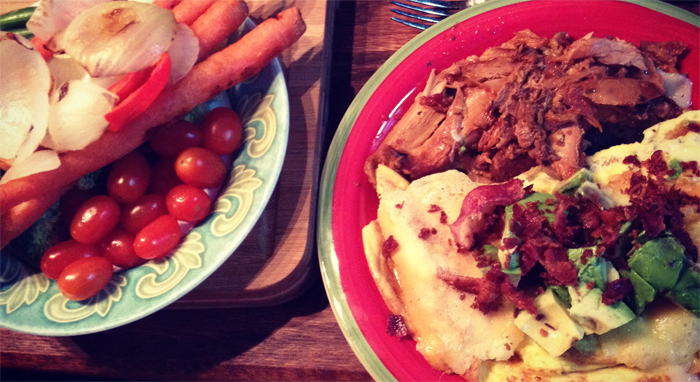
When you do the above, you’re telling your body that the muscles are important—certainly more important than they’ve ever been. And hopefully more important than any other kind of adaptation at this moment in time.
You’re also using up more energy with “extra” work in a way that (preferably) won’t interfere with the primary strength and power adaptations were after. The piece to overlay on top of this is nutrition, diet, supply—call it whatever you want.
Earlier I said that fat loss is all about balancing the energy equation. This is commonly stated:
- Energy intake > Energy output = Fat Gain
- Energy ouput > Energy intake = Fat Loss
I’m not going to argue thermodynamics. Energy can’t be created or destroyed. Got it. But what I do argue is that this is an overly simple look at the game we’re playing. Just as the goal in chess is to “capture” the king, all of the other pieces in play help you best accomplish this.
We can’t forget that:
- We’re breaking ourselves down via training and we need nutrients and not just energy to rebuild
- Giving ourselves nutrients can support more processes throughout the body—a laborer works better with more tools
- Giving ourselves nutrients can also contribute to feeling full and reduce our cravings; in other words: you won’t feel like death on a platter
- Eating good stuff that doesn’t promote inflammation is a good idea too, as causing further damage just gives the body something else to take care of that’s not your bulging biceps
- I could keep going but this would be another thousand word rant in itself, like the fact that eating a cooked potato delivers double the net energy value as a raw potato
You can lose weight by restricting calories ad infinitum, but I wouldn’t think that way. I think you’re better off eating “nature’s” foods because I think vitamins and minerals are good things to get into your system. This isn’t to say you can go hog wild eating an infinite amount of “natural” things, but it’s simply to say that eating things that give you vitamins and minerals you need to work around the clock to repair the damage you place upon yourself that also keep energy intake levels lower than their processed food counterparts.
Let’s face it: two potatoes are more filling and more nutritious than a bag of Doritos.
Most of us accept that what we eat probably plays a part in how our immune system functions, and yet we dismiss the fact that recovering from training involves the immune system. If you’re ripping away at your muscle tissue you need to give yourself what it needs to handle this stress, which is why I think you should (a) eat more protein than you think you need and (b) eat more vegetables than you think you need.
To this we can add:
- Lean protein
- Non-starchy vegetables
Simply because it helps keep energy intake low and gives you boatloads of vitamins and minerals your body needs to repair from the training stress.
Beyond this, we get into the fight of carbohydrates, insulin, and that whole abyss. Some say losing fat is impossible while also eating carbohydrates because of the insulinmonster.
My general philosophy here?
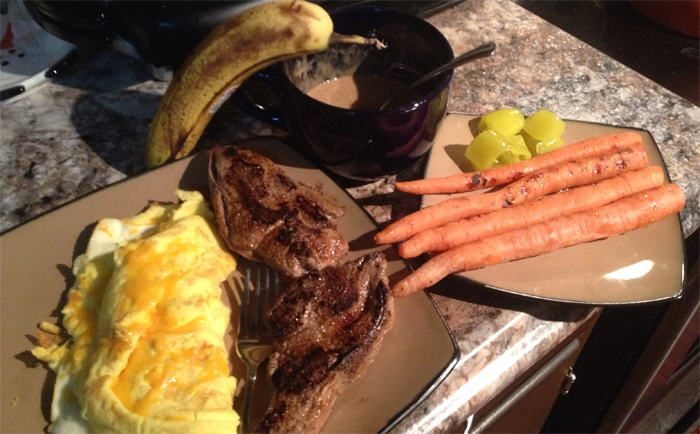
Go low carbohydrate. Not necessarily no carbohydrate. Just lower carbohydrate. Your muscles generally enjoy carbohydrates because carbohydrates are the preferential glycogen source. (If you’re confused, go back and read this.) Remember, training drives the adaptations (read this) and the reality is that we have to drop energy intake anyway.
We also know there is power in insulin, which means there’s potential power in carbohydrates (the primary macronutrient player with insulin). Even if there’s only a minuscule connection between carbohydrate intake and “re-sensitizing” your body’s ability to make use of insulin in the name of getting jacked down the line, I think it’s worth the short term lower carbohydrate plunge.
Voodoo? Maybe. Probably. But, hey, sometimes voodoo works.
After that, let fats trickle in here and there. If you’re eating fattier protein sources or cooking with fats, be mindful of extra fats. If not, then it might be best to get a little bit of nuts, avocado, or dense fat in without ruining the thermogenic game we have brewing.
Stage uno concerns
So the biggest concern with all of this: how is it doing any good for the muscles? Low energy intake atop strength training seems sketchy. I thought muscles needed more energy to build?
They do, but you have to remember that this is an evolution over time. Strength training is non-negotiable because the faster we convince the body that our muscles are important enough to warrant the tributary, the better off we are.
This is why I think it’s best to stick to nutritious foods, too. The more nutrients you deliver per energy capita, the more you have to work with. It’s better to have two guys building with an excess of tools than two guys trying to build with only enough tools for one.
Another note here: strength training shouldn’t be bodybuilderish. Knowing that energy-nutrients are on the slim side, there’s no need to go on a bodybuilder-esque split with tons of volume. Get stronger. Get better. But don’t do mounds and mounds of volume. Save that for when you’re really ready to build.
Can body fat build muscle?
Also, consider the very process of “losing fat.” When your body breaks down fat, it’s being used for some purpose.
A lot of people manage to gain muscle and lose fat at the beginning of this stage if they do things right. It doesn’t happen all the time and it isn’t exactly planned, but that’s the wonders of a novel stress.
Part of me wants to say that despite being in an external energy deficit, you’re not really operating in a deficit internally because your body is breaking down and using its stored energy.
This stored energy is used somewhere, and I’d guess it could allow incoming energy to be used for extra repairs—certainly more repairs than if you were in an energy deficit without an excess of stored body fat, which is troubling because our goal from the get go is to get rid of this excess.
This is why, at this stage, I don’t think cycling nutrients or any of that advanced junk is necessary or even useful.
The effects of getting leaner
As you lose body fat, you’re losing energy. You’re exhausting your reserves. And so at some point, despite this grandiose philosophy, you’re going to hit a point in which things need to change.
As fat loss continues and you get leaner you have less stored energy contributing. The lower energy intake overall gets the body thinking that energy might not be such an abundant resource.
You probably don’t have enough around to justify the investment of muscle. Things are looking grim. You might be on the cusp of the second stage of skinny-fat syndrome.
The second stage of skinny-fat syndrome and the skinny-fat solution
The tao of stubborn body fat and gollum cells
You can follow the principles in the first stage for a while, but most people hit a wall. Don’t be surprised when you do. The body isn’t a linear creature. It won’t wither itself into oblivion. You wouldn’t want it to do that, either.
I mean, think about it. You found a “diet” that helps you lose weight. Do you expect your body to just keeping withering away into nothingness? It doesn’t know that you’re doing it purposefully in the name of Quality, and so it’s only choice is to believe it’s going to live under these conditions for a while.
It adapts and changes and regulates itself based upon what it’s facing, and it usually does this whenever it gets close to dropping below a comfortable level of body fat.
“Alright, alright. I was cool getting rid of that other fat. But the fact is that I spent a bunch of time filling those suckers up in case of need. And, well, that need came to pass. I can’t just zap myself dry here. That other fat proved valuable, so I don’t think I can be so free spending anymore. I have to save this stuff. I have to save my presccissciicoooussssss.”
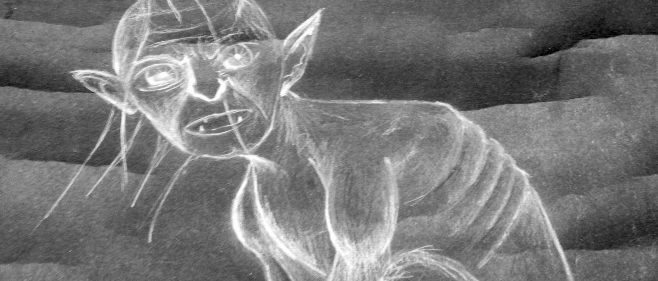
And now we’ve entered stubborn body fat land. Of course, my Gollum view of fat cells is a little less than scientific, but some folk smarter than me say that stubborn body fat is a real thing, and that it has a different chemical structure than “normal” body fat. This sorta’ backs up my story anyway and further fuels my advocacy for renaming these stubborn fat cells as gollum cells.
(And yes, that is a crinkled up picture of Gollum I drew about ten years ago.)
The dreaded starvation mode and calorie game
This is where we enter “starvation mode.” Starvation mode = “lock up.” In other words, your body says, “I’m starving. I’m going to lower my metabolic rate. I’m going to halt any investments. I’m going to bend your body composition desires over and violate them in ways that HBO wouldn’t even be able to capture.” Or something like that, I think.
The biggest implication here is that your body has decided that getting rid of the rest of your fat isn’t a good idea. Yet the calorie game comes into the picture again and we get the: just drop calories, dood! advice.
Alas, if your body has locked itself up in light of the energy-nutrient shortage, what do you think will happen if you dip further into the shortage? Oh sure, you might hit a point where you drop so low you start losing weight, but you might as well sign-up to be an extra in any movie that requires replicas of someone that lived in Nazi concentration camps.
Yes, it seems that in starvation mode muscle tissue is more expendable than gollum fat cells, and if you play the straight calorie game here and decide to drop calories low, well, good luck. Don’t be surprised if your muscle starts to go before your stubborn fat.
This sets me up perfectly for a silver bullet. Perhaps I could plug some sort of supplement here, or even my stubborn body fat guide that’s inside of The Skinny-Fat Solution.
But the most reliable way to get rid of stubborn body fat?
Time.
And that’s why I hate this stage, personally. I write about it because I know what it’s all about. I’ve been there. But I don’t know how much of what I use is voodoo vs. actual effectiveness vs. majin tactics.

I feel like the stubborn fat phase is the “go at this like you’re a chicken without a head” phase because the reality is that you’re forcing your body to do something it’s not comfortable doing: freak the body out enough for it to let lose its last bit of precious commodity in body fat.
You start with $1,000 the bank. You get to $500. Then $300. Then $200. Then $100, at which point your butthole puckers up. If you’re used to having extra fat around, convincing your body that having no extra isn’t a bad thing isn’t an easy task. And yes, convincing this takes time.
. . . but since I’m a glutton that never sat well with me, which is why I think there’s a way to get your body to make use of the energy quicker than father time could otherwise make happen. (For comparison purposes, I’m saying faster relative to just cruising on the original fat loss template waiting for your body to figure things out.)
But this is where sequence is important, because something like this only works if you’ve respected what came before it.
A second benefit of using stubborn body fat voodoo rather than waiting around for father time: you can get to the muscle building part faster. So, well, why not try?
Stimulating for stubborn fat loss
The body is breaking down and building up at all hours of the day. One of the things that encourages immediate breakdown of stored material is high sympathetic arousal. The example given by Dr. Robert Sapolsky in Why Zebras Don’t Get Ulcers goes a little something like this: you’re walking down the street, minding your own business when—oh no!—a lion pops out from around the street corner and starts chasing you.
In this situation, the body only cares about escaping the danger. It shunts all non-essential functions in the name of energy delivery, and so it’s a huge breakdown mode. Fat tissue is fair game, but so is muscle tissue.
(In fact if exercise intensity is lights out, muscle is probably more of a candidate because it’s quicker to make use of than fat. Fat is generally a slower source of fuel. I think most people twist their panties over short term muscle catabolism though, so I’d probably just ignore this if I were you.)
But here’s the thing: only non-working muscle tissue gets broken down. So with the lion, it doesn’t make sense to break down the muscle tissue in the legs, now does it? You need that stuff at that moment in time.
Consider this a “novel stress” kind of situation. Something freaks you out and you respond by, well, freaking out. And freaking out usually means breaking down a bunch of stuff to make use for immediate energy use.
The training you’re used to doing from Stage I is no longer novel. Just as if you saw that lion every day, your body would better cope with the stress—you wouldn’t freak out.

At one point, the initial strength work was probably freakoutable. But now? Less so. The fat loss work was never freakoutable and that was done on purpose because now is the time to make use of it. Remember, all stresses becomes un-novel when overdone. This is why, in my opinion, this stubborn fat loss step should be a shorter duration thing.
Suffice to say, the training should be of high intensity and also involve as much muscle as possible to prevent breakdown. This is where HIIT and Tabata and stuff that makes you puke becomes a worthy strategy.
Do I think this is necessary?
No. I think that with time you can convince the fat to fade away gently, but I’ve never been about gentle, which is why I’d rather slam it hard and get it over with. But in order to do this, you have to respect sequence.
We can get biochemical here and say that high intensity training methods have been shown to increase certain manly hormones beneficial for supporting muscle growth and fat burn. But the after burn (EPOC) and other things associated with HIIT isn’t exactly what we’re chasing. (Or we might be and I’m just off.) We’re simply chasing the fact that this novel sort of disgustingly tough training can potentially convince our body to let loose its stored energy.
And it’s only novel if you respect the sequence!
If you do this type of training from the start, when you actually hit this wall, then it won’t be so novel now will it? This enters that exact question: what do you do in this situation? Send me an email in about six months when I’ve thought about it long enough to have a worthwhile answer. I do know this though: most of these HIIT methods do require some prep work.
One does not simply walk into Tabata sprints or whatever other high intensity mutation is out there. I mean, you could. But I wouldn’t. That’s why Stage I walking and sprinting and rope jumping and all of that wonderful stuff is there; it prepares you for bigger and better things if need be.
The fate of muscle

During this training I don’t expect much muscle. It’s a short term strategy for those truly at the stubborn fat phase, which is something I talk about more in The Skinny-Fat Solution. Suffice to say, stubborn fat prevents four packs from becoming six packs. You don’t want to hop into this training prematurely.
The hard part here is plopping this kind of training atop your regular stuff without overworking yourself. HIIT is one of the most demanding types of training, and recovery should be accounted for. Again, if you’re doing HIIT on an off day, you’re a chicken without a head. (Don’t worry, as I was also a chicken without a head. Sometimes it’s better to brainlessly flap your wings than to over think things, I guess.)
During this stage, I’d probably even taper normal training volume down with an effort to keep intensity as high as possible. If you’re doing any kind of high intensity interval training, you’re condensing a bunch of volume into a short window. The last thing you probably need more of in your training is more volume.
Sadly, a lot of people add volume in a misguided attempt to lose fat and build muscle at the same time. It’s better to accept the loss and save your body’s adaptation reserve for true muscle building training when the time is right.
Stubborn fat and supply
I’d start to play around with intermittent fasting here if you thought that card was in your future. Say what you want, but the body is more prone to break down energy stores in a fasted state. That’s not saying it will negate having a sloppy nutritional profile all around, but that’s a caveat that’s sorta’ always understood. (It also doesn’t say it’s impossible to lose fat without intermittent fasting, which is also now a common belief.)
Also another good idea: cycling calories a tad. Maybe two higher calorie days. Nothing severe. Just something to remind the body that, hey, it’s not in that huge of a crisis mode and that it’s going to be alright. Remember, your body doesn’t know that it’s only going through a short term famine. You have to remind it that it’s going to be alright.
All in all, we’re hoping that the new kind of training will spark the changes we want. It’s not really the objective to drop energy-calories even lower. As mentioned, if you’re in this stage coming off the first, you’ve already found an energy-calorie intake that had the body dipping into storage. I’m not sure dropping it further would do you much good.
Either play chess with father time or visit the lion behind the brick wall. Let either one work their magic for a little while before making further adjustments.
The third stage of skinny-fat syndrome and the skinny-fat solution
Now this here third phase is something I pride myself in. I want to say I created it, but it sort of knocked me upside the head after many failed bulk and cut cycles. It may or may not be very scientific, but the fact is that neither my body nor outlook on training has been the same since doing this.
After the immense fat loss breakdown, your body wants to build back up. Fat included.
If you go back to the flinch: in the beginning we had a flinch to fat. Our goal was to downplay the flinch to fat and create a new flinch to muscle. Build the tributary. At this point, both of those things should going smoothly.
But the body isn’t a linear kind of creature. What gets done usually likes to get undone. What happens when your body spends a bunch of time filling up fat cells and then you go ahead and make use of the fat? Chances are it’s saying, “Gosh. Wow. This is incredible! Good thing I filled those suckers up. I should probably do it again in case this happens again.”
Call this a negative feedback loop, but times of catabolism and breakdown are sparks for anabolism and build up. If you’re coming off a stubborn fat loss phase and you’ve been strength training right, there’s a good chance that both your fat cells and muscle cells are “hungry.”
I suppose you could be “free” from here on out, but often times people just get right back on the fat train after losing a bunch of fat in an attempt to bulk up.
Why? Even though the fat cells aren’t full, they’re still there and ready to refill. The muscles probably are too which helps things, but most people associate getting off of a cut with going into a bulk. Granted, if you wanted to do a traditional bulk, now’s probably the time. But if you know my philosophy, I don’t usually recommend it.
The fat vs. muscle competition
All along we’ve been looking at this fat and muscle competition. I know it’s not that simple but it sure sounds nice. This “competition” is also known as nutrient partitioning, which basically describes what happens to excess nutrients when they’re eaten. In some cases, people give excess to body fat. In other cases, excess is given to muscle. I know I talked about this earlier, but it’s been a long while since then and I’m making sure you didn’t forget.
One of the things that obviously shifts this partitioning is the right kind of strength training. The other big thing? Not being a fat slob. (Because when you’re of a higher body fat, your body is more convinced with the flinch.)
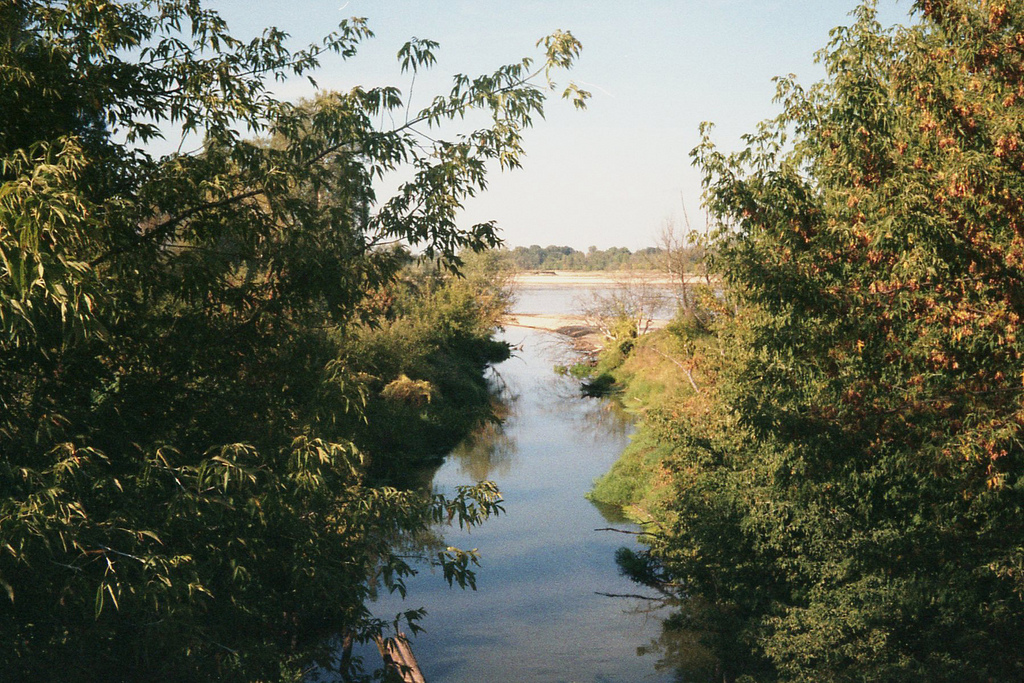
And so here we are. We’ve since began training the right way and we also lost fat. We’re in a much better spot for partitioning, which was the goal. It’s all about the flow of the river.
Although we could ride this reality out and bulk up, I like to skew partitioning even more by making the muscle cells even more hyperphagic. Yes, I just made this up because it makes me feel smart, so let me explain.
Hyperphagic muscle?
Even though we’ve bettered partitioning, the thing is that the fat cells are still probably hungry and there’s nothing you can do about it. What you can do, however, is convince the body that muscle is absolutely 100% the better investment.
And what’s the best way to do that? Do a bunch of training. And not necessarily bodybuilding training either, just constant cruise control training. Your body probably needs this after fat loss intense work anyway.
This is SOLDIER 1.0, which is basically the most detailed look at how to combine Chad Waterbury’s PLP and Dan John’s The 40 Day Program.
Now, I know not everyone will have the strength for T40DP and they might be better served on another program more conducive to strength, but I think PLP is a must. It’s easy enough to be done at home, too. I’ve written about my experiences combining these programs a lot, so you can re-read them:
Suffice to say, what combining these programs does is reinforce the need to tend to your muscles on a daily basis. You’re making it just about impossible for the body to decide to store excess as body fat because your muscles are showing such a high frequency of need.
Stage three supply
During this time, I recommend learning how to eat “normal.” Don’t bulk. Don’t cut. Just learn how to eat to maintain yourself.
This sounds silly, but often times when coming of times of fat loss you’re in a sticky situation. You’re weaning your way off of all this extra fat loss stuff, and you don’t know what to do. You’re dropping extra activity, so do you keep your diet the same? What if you increase calories? That means you’re not only ditching extra work but also increasing energy intake on the other end. What happens?
And so with this stage, you find those things out. I recommend dropping all fat loss work. If you wanted to include anything, just keep the sprints with the Stage I ethos.
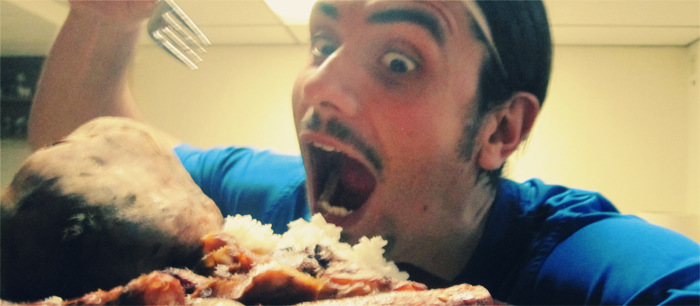
If I had to give you an overt goal, it would be to learn how to manipulate your body weight with nothing more than adjusting your feeding patterns, so this is where you’d dive into calorie cycling. Some days eat more; other days eat less. Begin to reintroduce more carbohydrates.
Being able to gain muscle without fat hinges on three skills:
- Knowing what you need to eat to lose weight
- Knowing what you need to eat to maintain weight
- Knowing what you need to eat to gain weight
Each of these skills is independent of training, and in order to move forward you should probably have the first two nailed down. That’s a good goal to set for this stage to combine with the training.
When it’s all said and done
And so after the third stage, I’d consider you beyond “reset.” You’re in a spot that has you ideal for gaining muscle without getting fat in the future, which is the pinnacle of places to be, in my opinion. I have my own philosophy on where you should go from here, but I know everyone has different motives.
This all was the skeleton of the methods that make The Skinny-Fat Solution. Consider it both the why and how of how I personally think about navigating the body composition world. Consider I just laid 5,000+ words on the subject in your lap, I’m not ashamed to say that if you want to learn absolutely everything that seeps out of my brain on skinny-fat syndrome, you should consider the investment in the resource.
You can see how it hinges on your initial body type, too. If you’re true skinny, then all three of these stages don’t even go down out of the gates. In other words, it’s called the skinny-fat solution for a reason.
So now that you’ve digested this massive article, there’s nothing holding you back, save for you. Get out there and do the work. Find out where you most likely are in relation to the three stages and don’t look back.
*We need to think context here again. Sometimes boosting mitochondrial adaptations is useful because better energy delivery means more sustained effort and better recovery in between stressful bouts. It’s a rabbit hole, yes. But stuff like this shouldn’t be on our radar yet. Save it for when you’re advanced enough to wrap your head around it. Learn how to bake good chocolate chip cookies before you branch off into the cake business. For most beginners, you just need basic strength work.
+++++